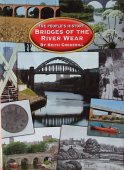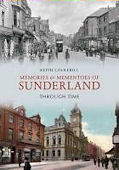|

May I suggest that you navigate the site via the
index on page 001. PRIOR PAGE / NEXT PAGE PRIOR PAGE / NEXT PAGE
To search for specific text on this page, just press 'CTRL +
F' & then enter your search term. A general site search facility is here.
Test.
Keith Cockerill presents on this page four slide shows for
your enjoyment. All of which can be viewed full screen.
And, lower on the page, additional material as follows:-
'THE RIVER WEAR AT WASHINGTON - ITS FORGOTTEN HISTORY'
a special 17 minute slideshow
with sound by Keith Cockerill
Click on the image second below to start the show. Enjoy!
But before you do so,
here is a fine image most appropriate to Keith's presentation. To illustrate
what the staiths, the sites & remains of so many of which are shown in Keith's
show, would have looked like - it depicts coal being moved by horse power to a staith building or depot where it
was stored as required & then loaded into waiting keelboats. We thank 'Pictures
in Print' for this wonderful & so appropriate image - you used to be able to view it in at their site,
which seems no longer to be available.
The print, by 'E. Barrass, mathematician of Chester-le-Street', was published in
'London Magazine' in Jan. 1766.

Here are
Keith Cockerill's words of introduction,
which he entitles:-
The Keelboats of Sunderland
The growth of
Sunderland as a town and port was greatly influenced by its expanding coal
trade. In the 19th and 20th centuries, overland colliery railways carried ever-increasing quantities of
coal from the Durham Coalfield to the river and docks at Sunderland to be
shipped either abroad or down the coast to London.
Before the
development of colliery railways however, a very different mode of transport
was used – the river itself. From the 17th century, coal was carried
from local collieries down wooden-railed waggonways by horse and gravity to the
many staiths on the rivers edge at Washington. Here it was transferred into
keelboats and taken downriver to Sunderland for transfer into ocean going
collier brigs.
For 40 years in
the 19th century, both the colliery railway and river transport
systems complemented each other, but the ever-increasing efficiency and
capacity of the overland railways eventually sounded the death knell for the
keelboat trade.
Today,
Washington’s riverside offers the rambler many enjoyable walks in a peaceful
rural setting, but few appreciate how busy this working river once was. Keith
Cockerill has used an 1826 map of the Wear by John Rennie to identify and
photograph the remains of the old staiths and quays along the river's edge at
Washington. He has produced a slideshow with a musical accompaniment and has
added a written commentary based on the observations of 19th century
Sunderland author Taylor Potts.
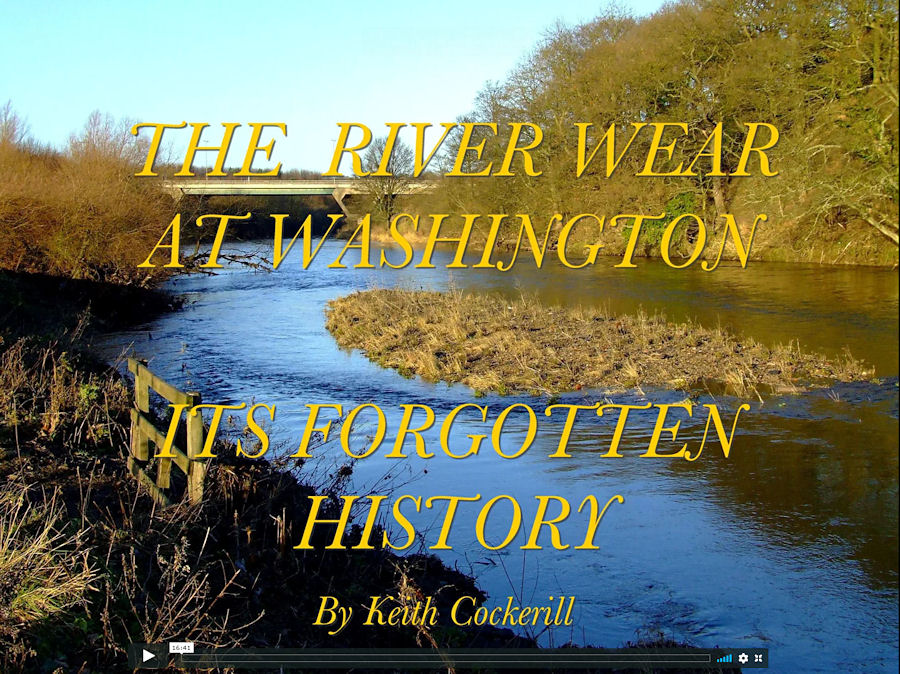
To access the video, click the
above image or click HERE.
'FOUR SEASONS ALONG THE RIVER WEAR AT WASHINGTON'
a fine 27 minute slideshow
with sound by Keith Cockerill
Here are
Keith Cockerill's words of introduction:-
Winter, Spring, Summer and Autumn: each season
brings its own unique splendour to the River Wear at Washington. The ebb and flow
of its tidal waters create a delightful ever-changing landscape but hidden away
amongst this rural backdrop lie the forgotten relics of an industrial past.
I have created a photographic diary of
Washington’s riverside throughout 2012 and have given it a musical
accompaniment. Here is an invitation to view that diary. I hope you enjoy
viewing it as much as I have enjoyed capturing it on camera!
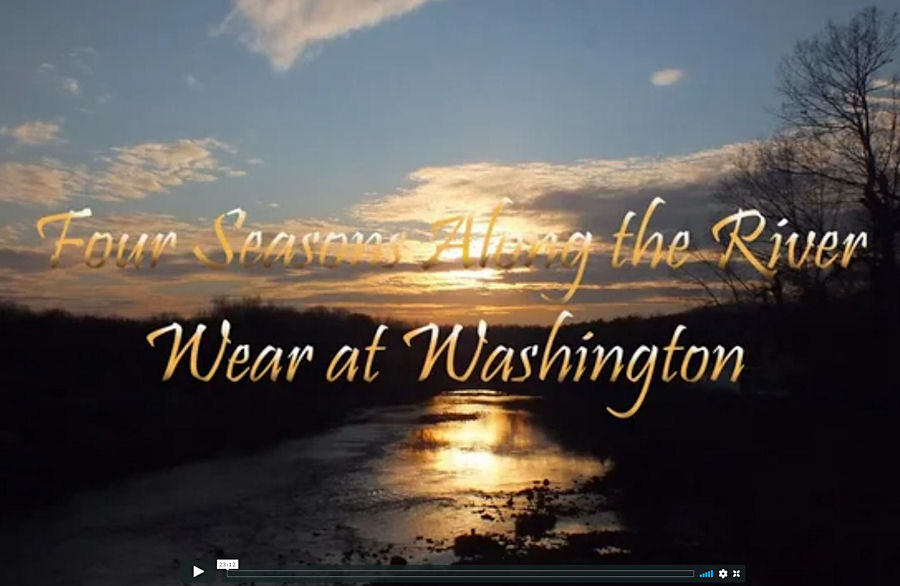
To access the video, click the
above image or click HERE.
'AROUND THE RIVERSIDE AT WASHINGTON - PICTURES FROM THE PAST & PICTURES
FROM THE PRESENT'
a fine 23 + minute slideshow
with sound by Keith Cockerill
Here are
Keith Cockerill's words of introduction:-
When Washington New Town was created 50 years ago, many of its older villages were changed or lost in the process as houses and buildings were selectively demolished. Many villagers voiced their disapproval at the break up of their
communities, non-more so than the residents of old Fatfield.
Villages and hamlets along the riverside were no exception to this fate, but great changes to the landscape also took place as redundant pit and chemical spoil heaps were
landscaped.
This slideshow uses archive photographs to show how the riverside
area and its surrounds once looked. Where appropriate, ‘past and present’ images are compared to highlight the changes that have taken place. The finale of the slideshow presents the riverside area of Washington as it looked
in 2014.

To access the video, click the
above image or click HERE.
'HOLY TRINITY CHURCH' - SUNDERLAND'S FIRST PARISH CHURCH
a 7 + minute slideshow
with sound by Keith Cockerill
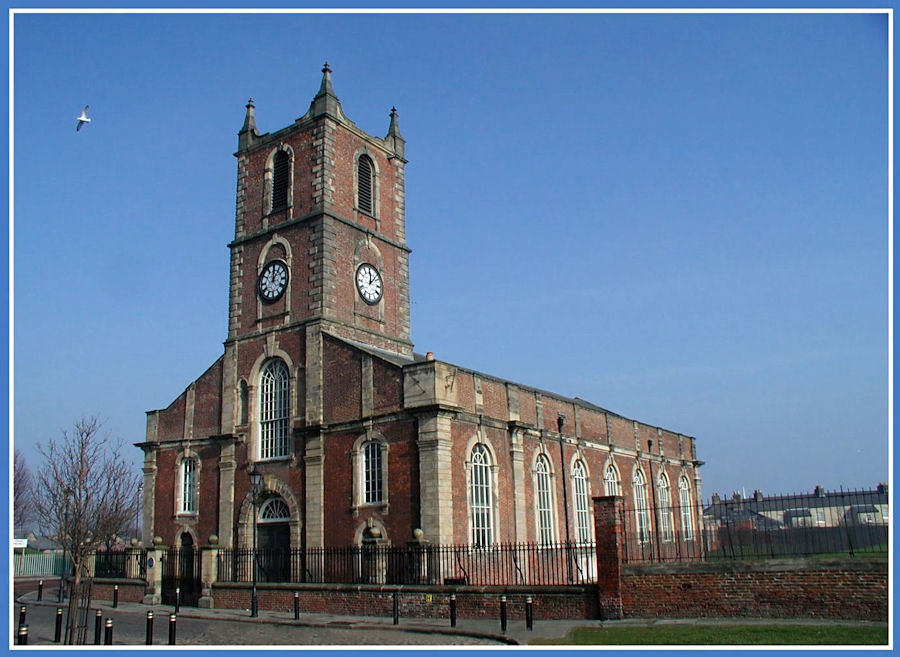
An updated 2006 slide show, available via 'Vimeo.com', which
features images of the church which can truly be described as splendid. Click the
above image or click HERE
to access.
KEITH COCKERILL'S PUBLISHED BOOKS
It seems only appropriate that I
should thank Keith Cockerill for providing the above slideshow - by listing here
such Keith Cockerill's works as an author, of which I become aware. That's Keith at far right.
1 |
'Bridges Of The River Wear', ISBN 1902527348, a soft cover 'Keith Cockerill' book, published in 2005 in 'The People's History' series. |
2 |
'Sunderland Through Time', ISBN 1848685769, a soft cover book, by 'Keith Cockerill', published by Amberley Publishing Plc, in 2009. |
3 |
'Memories and Mementoes of Sunderland Through Time', ISBN 1445602164, a soft cover book, by 'Keith Cockerill', published by Amberley Publishing Plc, in 2010. |
KEITH COCKERILL ATOP PENSHAW MONUMENT
Below, is Keith Cockerill atop the Penshaw monument on Aug. 29, 2011. He
cleverly managed to get a fine picture taken of himself with not another visitor
in sight. Very sneaky! You can see the image in a bigger & wider view here.

THE LIFE OF A SAILOR IN 19TH
CENTURY SUNDERLAND
a 'Cockerill' family history article by Keith Cockerill
What was life like for a sailor in
19th century Sunderland in the days of wooden sailing ships? The nautical rhymes and
mottoes on Sunderland-made pottery, often bought by sailors visiting the port,
give us a glimpse into how life may have been. Both happy and sad verses appeared
on our local pottery, perhaps to suit the ups and down of life as a sailor in
the town! Here is a verse reflecting the romantic notions of becoming a sailor
at this time. A rhyme indeed to persuade any young hearty lad to go to sea!

My great great grandfather Anthony
Cockerill & his brother William were two such young lads. They first went to
sea at around 14 years of age. Their father, Anthony Senior, was born in
Sunderland in 1797 to John Cockerill, mariner of Scarborough. Anthony Senior was
a cordwainer by trade, but had wisely invested in the ownership of several wooden
sailing vessels registered in the port of Sunderland. Full ownership meant
owning all 64 shares of a ship, but 32, 16, 8 or even less shares could be
bought, so a vessel often had several owners.
Being a sailor in Sunderland usually
meant working in the local coastal coal trade, but much foreign trading also
took place.
An ambitious sailor would aim to improve
his status as he gained experience, perhaps becoming mate or eventually master
of the ship! Here is another rhyme which illustrates the human nature of an aspiring
sailor as he rose through the ranks! - (note the
very old riveted repair to the jug handle)

In 1849, cordwainer Anthony Senior had
the 377 ton barque 'Cockerills' built for him at the local shipyard of William
Robinson. By 1852 his sons William and Anthony Junior had risen to become Master
Mariners and were captaining this and other vessels in the family fleet.
In early 1852, Anthony Junior was
waiting to board the ferry to Monkwearmouth, when a young lady called Ann
Wilson slipped on the icy ferry steps. Anthony helped her to her feet – he was so
taken by her that he contrived to be there every day to help her down those
steps! A few weeks later he proposed. They were secretly married and Ann wore
her wedding ring on a piece of string around her neck! – furthermore he did not
tell her that he was a ship’s captain until after they were married! Perhaps he
thought that knowledge of his profession would dissuade her from tying the
knot? As he left the port for his first foreign trip as a married man, Ann
wondered to herself if she would ever see him again!

The barque 'Cockerills' was sold on
in 1852, but kept its name and its ‘Cockerill’ Master Mariners. The years 1858
and 1859 proved to be trying ones for the family and ship. During a trip from
Marseilles to Boston, a severe gale drove the ship off course and the ship had
to put into Holm’s Hole, Massachusetts, on Dec. 9, 1858 with
damage. On Nov. 14 of the following year, a terrible disaster
unfolded! The ship was abandoned in a sinking state during a severe storm off
the island of Malta whilst carrying a cargo of barley from the Black Sea port
of Sulina in Romania, to the U.K. The crew and captain were rescued by the
Neapolitan brig 'Indifferente' and, on Nov. 15, 1859, safely taken to Malta.
(Webmaster Note - The Lloyd's Registers of 1850/51 thru 1858/59 all state
that Cockerill of Sunderland was the vessel's owner. The needed page in the
1859/60 edition is missing, while the barque is not listed in 1860/61)
On
Oct. 13, 1867,
Master Mariner Anthony Cockerill tragically died on the ‘high sea’ at age 38, whilst
sailing from Hamburg to Sunderland. An inquest held at the Salutation Inn,
Hendon Sunderland, concluded that having ‘expired suddenly’ on board the family
owned ship 'Star in the East', he had died from ‘natural causes’.

PS. When Master Mariner Anthony Junior died
in 1867, his son, also called Anthony, was barely 7 years old. He was placed into
the Sunderland Orphan Asylum, where he was educated and taught the skills of
seamanship.

Did he follow in the footsteps of his
father and become a sailor? No, he kept his feet on dry land in
Sunderland and became a cabinet maker!
A 'COCKERILL' FLEET LIST - in
sequence by year of build, mostly built in Sunderland - the list transcribed
from Keith Cockerill's fleet list, slightly adjusted.
BUILT IN SUNDERLAND
|
# |
Name |
Built |
Gross |
Built by |
Owned by |
When family owned |
Disposition |
1 |
Ariadne |
1814 |
|
Jas. Thompson? |
John Cockerill |
From 1847 |
|
2 |
Leander |
1819 |
118 |
Davison? |
Henry Longstaff & Anthony Cockerill |
From 1836 |
|
3 |
London |
1819 |
118 |
Unknown |
Henry Longstaff & Anthony Cockerill |
From 1836 |
|
4 |
Sea Flower |
1826 |
173 |
Unknown |
John Cockerill & Burton Brown |
From 1846 |
|
5 |
Jane |
1829 |
202 |
W. Chilton |
Henry Longstaff & Anthony Cockerill |
From 1837 |
|
6 |
Gowlands
(a brig or snow) |
1832 |
161 |
J. Bell |
George T. Gowland & Anthony Cockerill |
From 1847 |
|
7 |
Loyal Packet |
1837 |
239 |
R. & T. Andrews |
Anthony Cockerill |
From 1844 |
|
8 |
Water Lily
(a snow) |
1840 |
225 |
Atkinson & Pile |
Anthony Cockerill & Henry Longstaff |
From 1841 |
|
9 |
Tunstall |
1843 |
259 |
Rowntree |
Anthony Cockerill |
From 1844 |
|
10 |
Coverdale |
1845 |
286 |
J. Rogerson |
Anthony Cockerill |
From 1847 |
|
11 |
Cockerills (a barque) ON 16011 |
1849 |
377 |
William Robinson |
Anthony Cockerill |
From 1849 |
Details & sinking on Nov. 14, 1859 here |
12 |
Cromwell (a snow) |
1849 |
234 |
Robert Thompson & Sons |
John Cockerill & Burton Brown |
From 1849 |
Sold 50% of shares on Nov. 20, 1850 |
13 |
Star in the East (a barque) ON 11534 |
1850 |
308/314 later 287 & 277 |
Richard Wilkinson |
Anthony Cockerill |
From 1861 |
Sold 1869. Lost Oct. 1875 |
14 |
Jane Cockerell (a barque) ON 25695 |
1851 |
353/387 |
T. Stonehouse |
John Cockerill |
From 1851 |
Sold 1855/56 Note |
NOT BUILT IN SUNDERLAND
|
# |
Name |
Built |
Gross |
Built at |
Owned by |
When family owned |
Disposition |
15 |
Westmoreland |
1835 |
286 |
New Brunswick, Canada |
John Cockerill, Anthony Cockerill, John Robson & Mary Burdon |
From 1848 |
|
16 |
Ben Muick Dhui |
1848 |
306/244 |
Aberdeen |
Anthony Cockerill & William Cockerill |
From 1860 |
|
May I suggest that you navigate the site via the
index on page 001. PRIOR PAGE / NEXT PAGE PRIOR PAGE / NEXT PAGE
Do you want to make a comment? A site guestbook is here.
To the
Special Pages Index.
| A SITE SEARCH FACILITY
THE GUEST BOOK - GO
HERE
|
|
|





